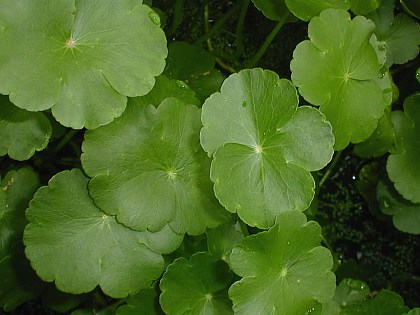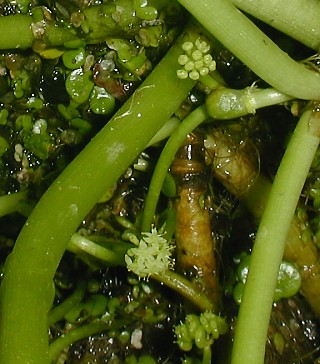Description: This perennial plant consists of horizontal stems that form roots at the nodes and basal leaves that develop directly from these stems. It is about 4-12" tall; this corresponds to the height of the basal leaves. The stems are pale green to brownish white, terete (round in cross-section), and glabrous; they are rather thick and fleshy and can float on water. Each basal leaf has a long erect petiole and a leaf blade that is up to 3" long and across. The petiole is pale green to pale reddish green, terete, and glabrous; it also rather fleshy like the stems, although a little less stout. The shape of the leaf blade is orbicular to orbicular-reniform; it is palmately lobed and crenate along the margin. The margin is usually cleft toward the middle of the leaf blade on one side; this corresponds to the junction of the petiole with the leaf blade. Elsewhere, the margin is more shallowly cleft into 3-5 lobes that are well-rounded. The upper surface of the leaf blade is yellowish green to dark green and glabrous.

Occasionally,
short flowering stalks develop from the horizontal stems. These stalks
are about 1-4" long (about one-third the length of the leaf petiole);
they are pale green, terete, and glabrous. Each stalk terminates in an
umbel of 5-13 flowers; this umbel is about ½" across or a little
larger. The star-like flowers are greenish white or greenish yellow.
Each flower has 5 spreading petals, 5 stamens, and a divided style. The
blooming period occurs during the summer or early fall. Upon maturity,
each flower is replaced by a small achene with 5 blunt ribs. The
achenes can float on water, distributing this plant to new locations.
The root system consists of masses of fine fibrous roots; these roots
can penetrate the soil or drift in the water from the stems. Water
Pennywort often forms large dense colonies of plants in muddy soil or
shallow water.
Cultivation:
The preference is full sun to light shade, wet conditions, and mucky
soil or shallow water (slow-moving or stagnant). This species can
spread aggressively.
Range & Habitat:
Water Pennywort is a rare plant that is state-listed as 'endangered.'
It is thought to be native to Clinton County in southern Illinois,
while elsewhere in the state it is probably introduced or adventive
(see Distribution
Map). The webmaster has recently observed a large colony of
this species in Vermilion County, Illinois. Typical habitats are
marshes, swamps, and ponds. In Europe, Water Pennywort is considered an
invasive species. Considering its tendency to develop large
colonies,
it is surprising that this species isn't more common in North America
than it is.
webmaster has recently observed a large colony of
this species in Vermilion County, Illinois. Typical habitats are
marshes, swamps, and ponds. In Europe, Water Pennywort is considered an
invasive species. Considering its tendency to develop large
colonies,
it is surprising that this species isn't more common in North America
than it is.
Faunal Associations:
Information about floral-faunal relationships for this species is
currently unavailable. The small flowers, which are hidden by the
foliage, appear to attract few insect visitors.
Photographic Location:
A sandy marsh in Vermilion County, Illinois.
Comments:
The attractive leaves of Water Pennywort resemble those of Nasturtiums
– an introduced horticultural plant that is often cultivated in flower
gardens. However, this resemblance is superficial, as they are members
of different plant families. The expression 'Pennywort' refers to a
European species with smaller leaves; Water Pennywort has larger leaves
that are about the same size as a silver dollar. There are several Hydrocotyle
spp. (Pennyworts) that occur in scattered areas of the
Midwest; these are mostly wetland species. Because they appear similar
to each other, it can be difficult to distinguish these species. Some
Pennyworts have peltate leaf blades (i.e., their petioles join the
middle of the leaf blades, remaining remote from the leaf margins),
while other Pennyworts have non-peltate leaf blades (i.e., their
petioles join the edge of the leaf blades where the leaf margin
occurs). Water Pennywort is deceptive in this regard: Although its leaf
blades appear to be peltate, there are actually non-peltate. This is
because its leaf blades are cleft to the middle on one side where the
petiole joins the blade. Pennyworts also vary in the length of their
flowering stalks and the number of flowers per umbel. Water Pennywort
has short stalks (about 1-4" long) and 5-13 flowers per umbel. It also
has larger leaves than most Pennyworts. Some Pennyworts produce more
than one umbel per flowering stalk, but Water Pennywort produces a
single umbel per stalk. Another common name of Hydrocotyle
ranunculoides is Floating Pennywort.